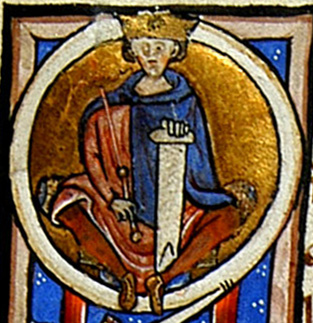
Alfonso Jordan, also spelled Alfons Jordan or Alphonse Jourdain (1103–1148), was the Count of Tripoli (1105–09), Count of Rouergue (1109–48) and Count of Toulouse, Margrave of Provence and Duke of Narbonne (1112–48).
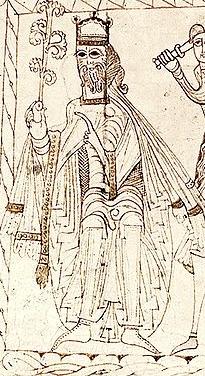
Alfonso VII, called the Emperor, became the King of Galicia in 1111 and King of León and Castile in 1126. Alfonso, born Alfonso Raimúndez, first used the title Emperor of All Spain, alongside his mother Urraca, once she vested him with the direct rule of Toledo in 1116. Alfonso later held another investiture in 1135 in a grand ceremony reasserting his claims to the imperial title. He was the son of Urraca of León and Raymond of Burgundy, the first of the House of Ivrea to rule in the Iberian peninsula.
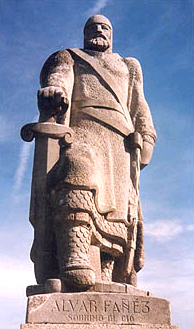
Álvar Fáñez was a Leonese nobleman and military leader under Alfonso VI of León and Castile, becoming the nearly independent ruler of Toledo under Queen Urraca. He became the subject of legend, being transformed by the Poema de Mio Cid, Spain's national epic, into Álvar Fáñez Minaya, a loyal vassal and commander under Rodrigo Diaz de Vivar, El Cid, during the latter's exile and his conquest of Valencia.
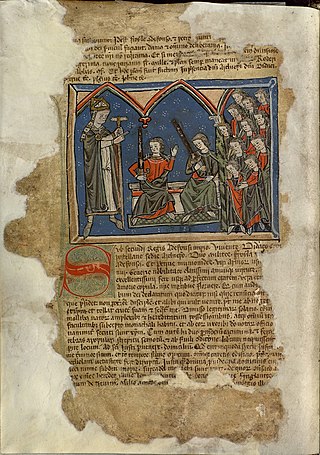
Diego Gelmírez or Xelmírez was the second bishop and first archbishop of the Catholic Archdiocese of Santiago de Compostela in Galicia, modern Spain. He is a prominent figure in the history of Galicia and an important historiographer of the Iberia of his day. Diego involved himself in many quarrels, ecclesiastical and secular, which were recounted in the Historia Compostelana, which covered his episcopacy from 1100 to 1139 and serves as a sort of gesta of the bishop's life.

The Carmen Campi Doctoris is an anonymous medieval Latin epic poem, consisting of 32 accentual-syllabic Sapphic stanzas, for a total of 128 lines, with one line from an unfinished thirty-third. It is the earliest poem about the Spanish folk hero El Cid Campeador, and was found in the monastery of Santa Maria de Ripoll in the 17th century, after which it was transferred to the Bibliothèque nationale de France where it currently resides as manuscript lat. 5132.
Ramiro Garcés was the second son of king García Sánchez III of Pamplona and queen Stephania. He was a powerful nobleman in the region around Nájera and Calahorra and a major figure at the courts of both Navarre and Castile. He was ambushed and killed while trying to take possession of the castle of Rueda de Jalón during the Reconquista.
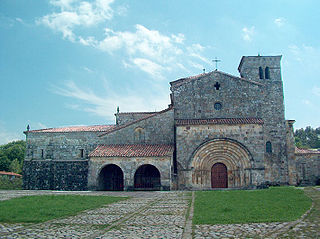
Fernando Díaz was a Spanish nobleman and military leader in the Kingdom of León, the most powerful Asturian magnate of the period. He held the highest rank in the kingdom, that of count, from at least 24 September 1089. He was the last Count of Asturias de Oviedo and was succeeded by a castellan, a novus homo, perhaps in an ecclesiastical–royal effort to curtail the power of the Asturian aristocracy.
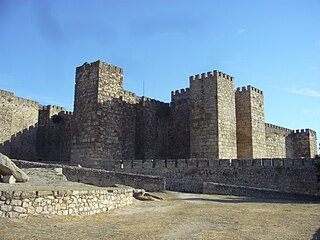
Fernando Rodríguez de Castro (1125–1185) was a Castilian nobleman, statesman and military leader who made his career in León. He was the leader of the House of Castro during the civil wars that followed the death of Sancho III of Castile and the succession of the infant Alfonso VIII. He was nicknamed el Castellano in León and el Leonés in Castile.

Ramiro Fróilaz was a Leonese magnate, statesman, and military leader. He was a dominant figure in the kingdom during the reigns of Alfonso VII and Ferdinand II. He was primarily a territorial governor, but also a court figure, connected to royalty both by blood and by marriage. The military exploits of his sovereigns involved him against both the neighbouring kingdoms of Navarre and Portugal and in the Reconquista of the lands of al-Andalus.
The Treaty of Sahagún ended a state of war between the Castile and León, establishing pacem et ueram amiciciam between their respective monarchs, Sancho III and Ferdinand II, who called themselves boni fratres et boni amici. It was signed at the monastery of Sahagún on 23 May 1158.

Suero Vermúdez was an Asturian nobleman, territorial governor, and military leader. His career was marked by loyalty to the crown of León-Castile during the reigns of Alfonso VI, Urraca, and Alfonso VII. He never took part in any revolt, but fought in many wars against rebels, against rivals, and against the Moors.

The siege of Bayonne was launched by Alfonso the Battler, King of Aragon and Navarre, apparently against the Duke of Aquitaine, William X, and lasted from October 1130 to October 1131. The city of Bayonne was then a part of Aquitaine, nominally a part of France. The chief narrative source for the siege of Bayonne is the Chronica Adefonsi imperatoris, a contemporary account of events in Spain compiled to celebrate the feats of Alfonso VII of León and Castile. The siege began with knights, infantry, and siege engines and included the plundering of the environs of the city and assaults on its walls. The arrival of a relief army led to a famous joust and the prolongation of the siege. The siege was a failure, and was lifted after Alfonso had made his famous last will and testament.

García Garcés de Aza was a Castilian magnate "renowned for his wealth and dullness", yet "a prominent figure in the later Andalusian campaigns of the Emperor between 1150 and 1157". His toponymic appears in contemporary documents, referring to his ownership of the tenencia of Aza. His patronymic, "Garcés", reflects that he was son of count García Ordóñez, born to the latter's second wife, Eva, probably a Frenchwoman. After the death of García Ordóñez, she remarried to Pedro González de Lara, making García Garcés half-brother of Eva's children by Pedro and closely allied with the House of Lara.
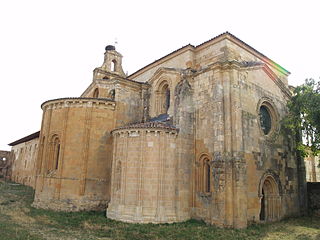
Ponce de Minerva was a nobleman, courtier, governor, and general serving, at different times, the kingdoms of León and Castile. Originally from Occitania, he came as a young man to León (1127), where he was raised probably in close connexion to the royal family. His public career, first as a courtier and knight in the military retinue of Alfonso VII of León and Castile, began in 1140. By later historians he was implicated in the strife between Alfonso's successors, Sancho III of Castile and Ferdinand II of León, but he was generally loyal to the latter, although from 1168 to 1173 he was in voluntary exile serving Alfonso VIII of Castile.
In medieval Iberia, an alférez or alferes was a high-ranking official in the household of a king or magnate. The term is derived from the Arabic الفارس (al-fāris), meaning "knight" or "cavalier", and it was commonly Latinised as alferiz or alferis, although it was also translated into Latin as armiger or armentarius, meaning "armour-bearer". The connection with arms-bearing is visible in several Latin synonyms: fertorarius, inferartis, and offertor. The office was sometimes the same as that of the standard-bearer or signifer. The alférez was generally the next highest-ranking official after the majordomo. He was generally in charge of the king or magnate's mesnada, his personal retinue of knights, and perhaps also of his armoury and his guard. He generally followed his lord on campaign and into battle.
Guy de Lons, also known as Gui or Guido de Loth, was the Bishop of Lescar from 1115 to 1141. He made extensive travels in Spain on four occasions, three as Papal legate. He began construction on the extant Lescar Cathedral in 1120.

The second siege of Coria by the Emperor Alfonso VII of León was begun in early May 1142 and ended with the taking of the town in June. Coria had previously been reconquered in 1079 by Alfonso VI. It was lost to the Almoravids sometime not long after Alfonso's death in 1109. Alfonso VII had vainly besieged it in July 1138, in which action his general Rodrigo Martínez was killed. The successful siege of 1142 was "the prelude to a frenetic bout of military activity during the latter part of the reign of Alfonso VII [during which] the emperor is known to have led in person at least eight military expeditions into al-Andalus."

The siege of Coria in July 1138 was the first and shorter of two attempts by Alfonso VII of León to take the city of Coria in Muslim Spain. Coria had previously been reconquered in 1079 by Alfonso VI, but was lost to the Almoravids not long after Alfonso's death in 1109. On the heels of a successful razzia (raid) deep into Islamic al-Andalus, Alfonso VII briefly invested the city before retiring. A second siege in 1142 was successful.
The Poem of Almería is a medieval Latin epic poem in 3851⁄2 leonine hexameters. It was appended to the end of the Chronica Adefonsi imperatoris, an account of the reign of Alfonso VII of León and Castile, and narrates the victorious military campaign of 1147 that culminated in the conquest of the port of Almería. The poem, as it survives, is unfinished, abruptly ending mid-line before recounting the actual siege of Almería itself. Of its surviving lines, 293 consist of "dénombrement épique, a stirring roll-call of the chief members and contingents of the army".
Pelayo Menéndez was the bishop of Tui (Túy) from 1131 until his death. He was the fourth bishop after the restoration of the diocese (1070), which had fallen into abeyance in the tenth century as a result of Viking and Moorish raids.













